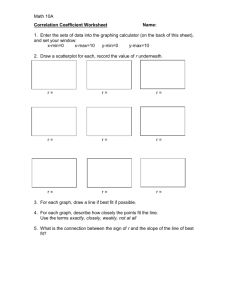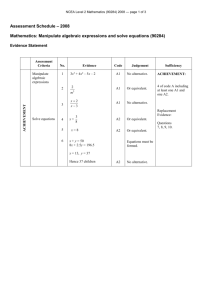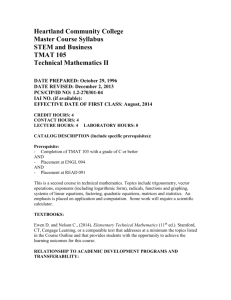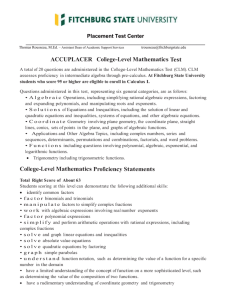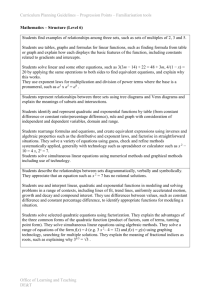Year 10 plan: Mathematics exemplar (DOCX, 247 kB )
advertisement
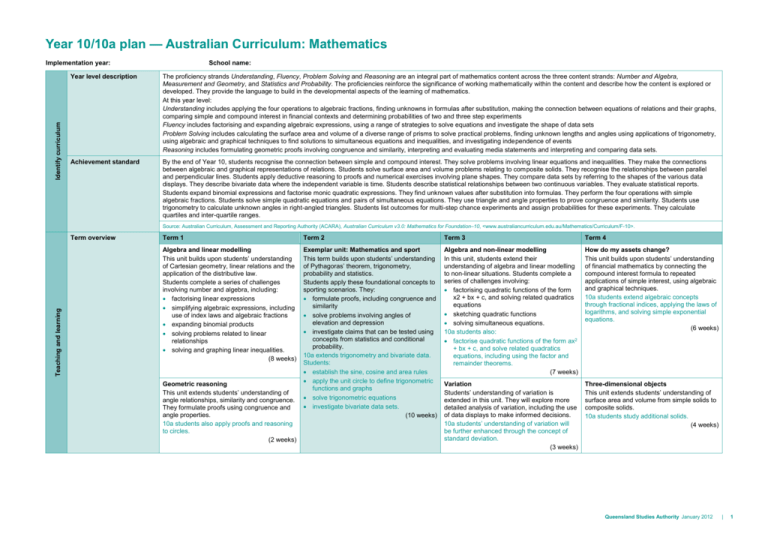
Year 10/10a plan — Australian Curriculum: Mathematics Identify curriculum Implementation year: School name: Year level description The proficiency strands Understanding, Fluency, Problem Solving and Reasoning are an integral part of mathematics content across the three content strands: Number and Algebra, Measurement and Geometry, and Statistics and Probability. The proficiencies reinforce the significance of working mathematically within the content and describe how the content is explored or developed. They provide the language to build in the developmental aspects of the learning of mathematics. At this year level: Understanding includes applying the four operations to algebraic fractions, finding unknowns in formulas after substitution, making the connection between equations of relations and their graphs, comparing simple and compound interest in financial contexts and determining probabilities of two and three step experiments Fluency includes factorising and expanding algebraic expressions, using a range of strategies to solve equations and investigate the shape of data sets Problem Solving includes calculating the surface area and volume of a diverse range of prisms to solve practical problems, finding unknown lengths and angles using applications of trigonometry, using algebraic and graphical techniques to find solutions to simultaneous equations and inequalities, and investigating independence of events Reasoning includes formulating geometric proofs involving congruence and similarity, interpreting and evaluating media statements and interpreting and comparing data sets. Achievement standard By the end of Year 10, students recognise the connection between simple and compound interest. They solve problems involving linear equations and inequalities. They make the connections between algebraic and graphical representations of relations. Students solve surface area and volume problems relating to composite solids. They recognise the relationships between parallel and perpendicular lines. Students apply deductive reasoning to proofs and numerical exercises involving plane shapes. They compare data sets by referring to the shapes of the various data displays. They describe bivariate data where the independent variable is time. Students describe statistical relationships between two continuous variables. They evaluate statistical reports. Students expand binomial expressions and factorise monic quadratic expressions. They find unknown values after substitution into formulas. They perform the four operations with simple algebraic fractions. Students solve simple quadratic equations and pairs of simultaneous equations. They use triangle and angle properties to prove congruence and similarity. Students use trigonometry to calculate unknown angles in right-angled triangles. Students list outcomes for multi-step chance experiments and assign probabilities for these experiments. They calculate quartiles and inter-quartile ranges. Source: Australian Curriculum, Assessment and Reporting Authority (ACARA), Australian Curriculum v3.0: Mathematics for Foundation–10, <www.australiancurriculum.edu.au/Mathematics/Curriculum/F-10>. Teaching and learning Term overview Term 1 Term 2 Term 3 Term 4 Algebra and linear modelling This unit builds upon students’ understanding of Cartesian geometry, linear relations and the application of the distributive law. Students complete a series of challenges involving number and algebra, including: factorising linear expressions simplifying algebraic expressions, including use of index laws and algebraic fractions expanding binomial products solving problems related to linear relationships solving and graphing linear inequalities. (8 weeks) Exemplar unit: Mathematics and sport This term builds upon students’ understanding of Pythagoras’ theorem, trigonometry, probability and statistics. Students apply these foundational concepts to sporting scenarios. They: formulate proofs, including congruence and similarity solve problems involving angles of elevation and depression investigate claims that can be tested using concepts from statistics and conditional probability. 10a extends trigonometry and bivariate data. Students: establish the sine, cosine and area rules apply the unit circle to define trigonometric functions and graphs solve trigonometric equations investigate bivariate data sets. (10 weeks) Algebra and non-linear modelling In this unit, students extend their understanding of algebra and linear modelling to non-linear situations. Students complete a series of challenges involving: factorising quadratic functions of the form x2 + bx + c, and solving related quadratics equations sketching quadratic functions solving simultaneous equations. 10a students also: factorise quadratic functions of the form ax2 + bx + c, and solve related quadratics equations, including using the factor and remainder theorems. (7 weeks) How do my assets change? This unit builds upon students’ understanding of financial mathematics by connecting the compound interest formula to repeated applications of simple interest, using algebraic and graphical techniques. 10a students extend algebraic concepts through fractional indices, applying the laws of logarithms, and solving simple exponential equations. (6 weeks) Variation Students’ understanding of variation is extended in this unit. They will explore more detailed analysis of variation, including the use of data displays to make informed decisions. 10a students’ understanding of variation will be further enhanced through the concept of standard deviation. (3 weeks) Three-dimensional objects This unit extends students’ understanding of surface area and volume from simple solids to composite solids. 10a students study additional solids. (4 weeks) Geometric reasoning This unit extends students’ understanding of angle relationships, similarity and congruence. They formulate proofs using congruence and angle properties. 10a students also apply proofs and reasoning to circles. (2 weeks) Queensland Studies Authority January 2012 | 1 Teaching and learning Aboriginal and Torres Strait Islander perspectives Mathematics provides opportunities for students to strengthen their appreciation and understanding of Aboriginal peoples and Torres Strait Islander peoples and their living cultures. Specific content and skills within relevant sections of the curriculum can be drawn upon to encourage engagement with: Aboriginal and Torres Strait Islander frameworks of knowing and ways of learning Social, historical and cultural contexts associated with different uses of mathematical concepts in Australian Indigenous societies Aboriginal peoples’ and Torres Strait Islander peoples’ contributions to Australian society and cultures. Mathematics provides opportunities to explore aspects of Australian Indigenous knowing in connection to, and with guidance from, the communities who own them. Using a respectful inquiry approach, students have the opportunity to explore mathematical concepts in Aboriginal and Torres Strait Islander lifestyles including knowledge of number, space, measurement and time. Through these experiences, students have opportunities to learn that Aboriginal peoples and Torres Strait Islander peoples have sophisticated applications of mathematical concepts which may be applied in other peoples’ ways of knowing. General capabilities and cross-curriculum priorities Opportunities to engage with: Key to general capabilities and cross-curriculum priorities Literacy Numeracy Opportunities to engage with: ICT capability Critical and creative thinking Aboriginal and Torres Strait Islander histories and cultures Term 1 Make judgments and use feedback 2 | Asia and Australia’s engagement with Asia Term 2 Week Assessment instrument Week 9 Supervised assessment: Short response (Written) Solve problems related to: linear relationships and inequalities binomial products algebraic expressions. 7 9 Moderation Ethical behaviour Personal and social capability Opportunities to engage with: Intercultural understanding Sustainability A folio is a targeted selection of evidence of student learning and includes a range of responses to a variety of assessment techniques. A folio is used to make an overall on-balance judgment about student achievement and progress at appropriate points and informs the reporting process. Develop assessment Assessment For advice and guidelines on assessment, see www.qsa.qld.edu.au Opportunities to engage with: Teachers develop tasks and plan units. Before the written task, teachers discuss taskspecific descriptors of the quality of student performance. Teachers individually mark all student responses, applying the shared understanding achieved through this calibration process. Year10/10a plan Australian Curriculum: Mathematics Term 3 Assessment instrument Modelling and problem-solving task (Written) Solve an extended problem using conditional probability The following assessment packages in the QSA Assessment Bank could be used in this unit: 501 Forty years from now. Term 4 Week Assessment instrument Week Assessment instrument 9 Supervised assessment: Short response (Written) Solve problems related to: quadratic functions simultaneous equations variation. 6 Mathematical investigation: Report (Written) Investigate housing loans. 9 Supervised assessment: Short response (Written) Solve problems related to surface area and volume. Supervised assessment: Short response and Multiple Choice Solve problems related to: congruence and similarity angles of elevation and depression probabilities of events. Teachers develop tasks and plan units. Teachers mark student responses individually, then select samples representative of the A–E qualities for moderation. Teachers moderate samples to ensure consistency of judgments. Teachers develop tasks and plan units. Teachers mark a small random sample of the report task, moderate the samples to ensure consistency of judgments, then mark their own class. Teachers develop tasks and plan units. Before the written tasks, teachers discuss task-specific descriptors of the quality of student performance. Teachers individually mark all student responses, applying the shared understanding achieved through this calibration process. Year 10/10a Mathematics: review for balance and coverage of content descriptions Number and Algebra 1 2 3 4 Number and Algebra Money and financial mathematics Linear and non-linear relationships (10a) Connect the compound interest formula to repeated applications of simple interest using appropriate digital technologies (ACMNA229) Solve simple exponential equations (ACMNA270) Define rational and irrational numbers and perform operations with surds and fractional indices (ACMNA264) Use the definition of a logarithm to establish and apply the laws of logarithms (ACMNA265) 3 Factorise monic and non-monic quadratic expressions and solve a wide range of quadratic equations derived from a variety of contexts (ACMNA269) Simplify algebraic products and quotients using index laws (ACMNA231) Using units of measurement Apply the four operations to simple algebraic fractions with numerical denominators (ACMNA232) Solve problems involving surface area and volume for a range of prisms, cylinders and composite solids (ACMMG242) Expand binomial products and factorise monic quadratic expressions using a variety of strategies (ACMNA233) Substitute values into formulas to determine an unknown (ACMNA234) Measurement and Geometry Patterns and algebra (10a) Investigate the concept of a polynomial and apply the factor and remainder theorems to solve problems (ACMNA266) Linear and non-linear relationships Solve problems involving linear equations, including those derived from formulas (ACMNA235) Solve linear inequalities and graph their solutions on a number line (ACMNA236) 1 2 Solve problems involving parallel and perpendicular lines (ACMNA238) Explore the connection between algebraic and graphical representations of relations such as simple quadratics, circles and exponentials using digital technology as appropriate (ACMNA239) Geometric reasoning Formulate proofs involving congruent triangles and angle properties (ACMMG243) Apply logical reasoning, including the use of congruence and similarity, to proofs and numerical exercises involving plane shapes (ACMMG244) Describe the results of two- and three-step chance experiments, both with and without replacements, assign probabilities to outcomes and determine probabilities of events. Investigate the concept of independence (ACMSP246) Use the language of ‘if ....then, ‘given’, ‘of’, ‘knowing that’ to investigate conditional statements and identify common mistakes in interpreting such language (ACMSP247) 3 4 Investigate reports of studies in digital media and elsewhere for information on their planning and implementation (ACMSP277) Determine quartiles and interquartile range (ACMSP248) Construct and interpret box plots and use them to compare data sets (ACMSP249) Compare shapes of box plots to corresponding histograms and dot plots (ACMSP250) Use scatter plots to investigate and comment on relationships between two numerical variables (ACMSP251) Investigate and describe bivariate numerical data where the independent variable is time (ACMSP252) Evaluate statistical reports in the media and other places by linking claims to displays, statistics and representative data (ACMSP253) Calculate and interpret the mean and standard deviation of data and use these to compare data sets (ACMSP278) Establish the sine, cosine and area rules for any triangle and solve related problems (ACMMG273) Use information technologies to investigate bivariate numerical data sets. Where appropriate use a straight line to describe the relationship, allowing for variation (ACMSP279) Use the unit circle to define trigonometric functions, and graph them with and without the use of digital technologies (ACMMG274) Solve simple trigonometric equations (ACMMG275) Apply Pythagoras’ theorem and trigonometry to solving three-dimensional problems in right-angled triangles (ACMMG276) Solve right-angled triangle problems including those involving direction and angles of elevation and depression (ACMMG245) 2 Data representation and interpretation (10a) Pythagoras and trigonometry (10a) 4 Pythagoras and trigonometry Solve linear simultaneous equations, using algebraic and graphical techniques including using digital technology (ACMNA237) 3 Solve problems involving surface area and volume of right pyramids, right cones, spheres and related composite solids (ACMMG271) Prove and apply angle and chord properties of circles (ACMMG272) 1 Data representation and interpretation Geometric reasoning (10a) Statistics and Probability Chance (10a) Using units of measurement (10a) Apply understanding of polynomials to sketch a range of curves and describe the features of these curves from their equation (ACMNA268) Factorise algebraic expressions by taking out a common algebraic factor (ACMNA230) 4 Chance Patterns and algebra Solve simple quadratic equations using a range of strategies (ACMNA241) 2 Describe, interpret and sketch parabolas, hyperbolas, circles and exponential functions and their transformations (ACMNA267) Real numbers (10a) Solve linear equations involving simple algebraic fractions (ACMNA240) 1 Source: Australian Curriculum, Assessment and Reporting Authority (ACARA), Australian Curriculum v3.0: Mathematics for Foundation–10, <www.australiancurriculum.edu.au/Mathematics/Curriculum/F-10>. Queensland Studies Authority January 2012 | 3

